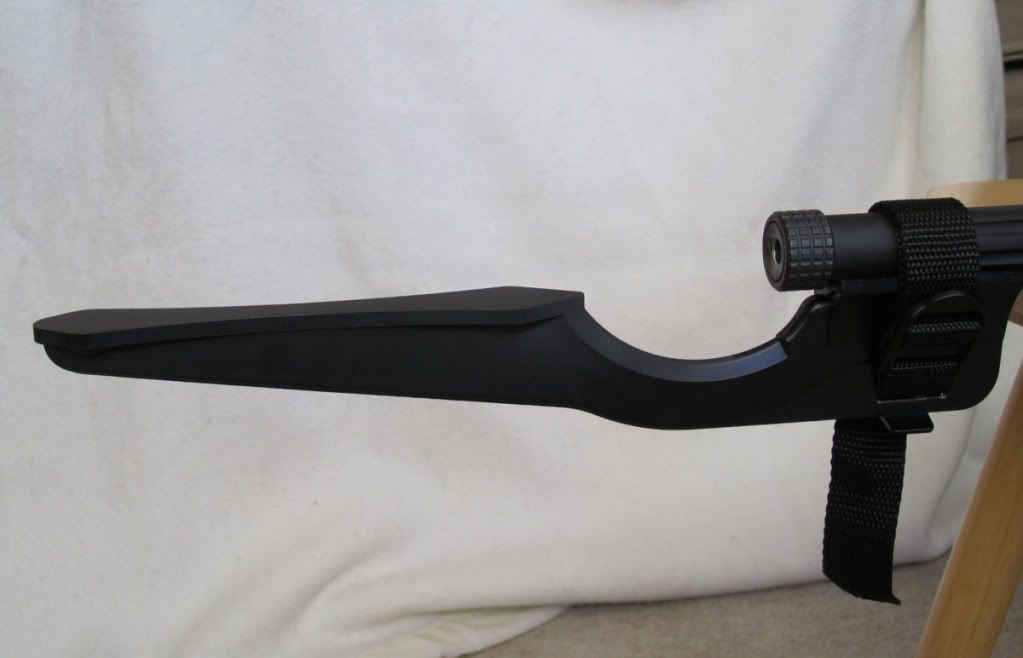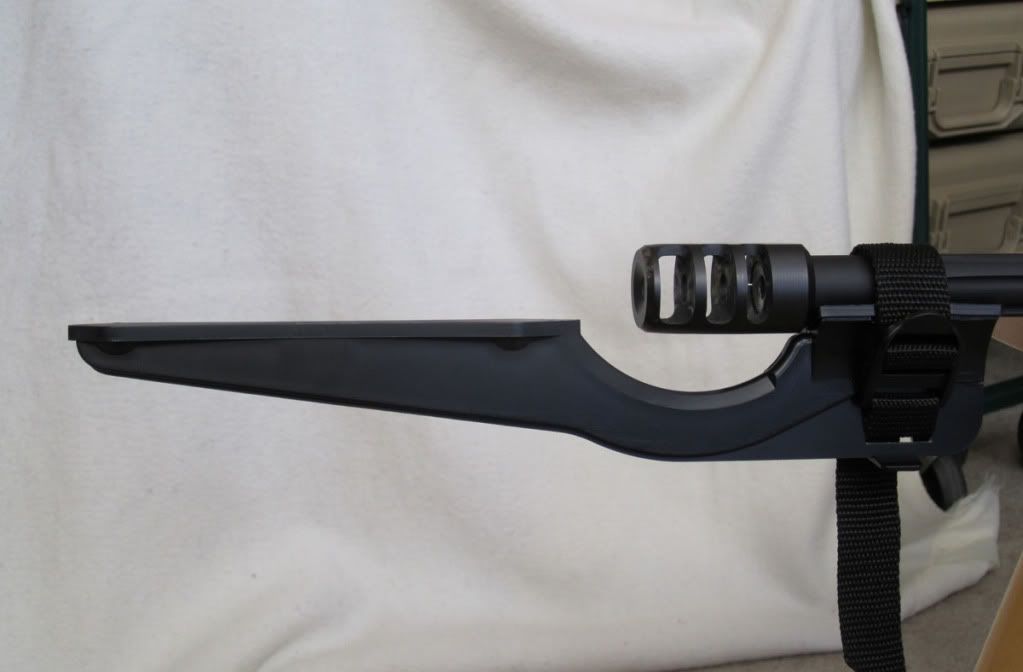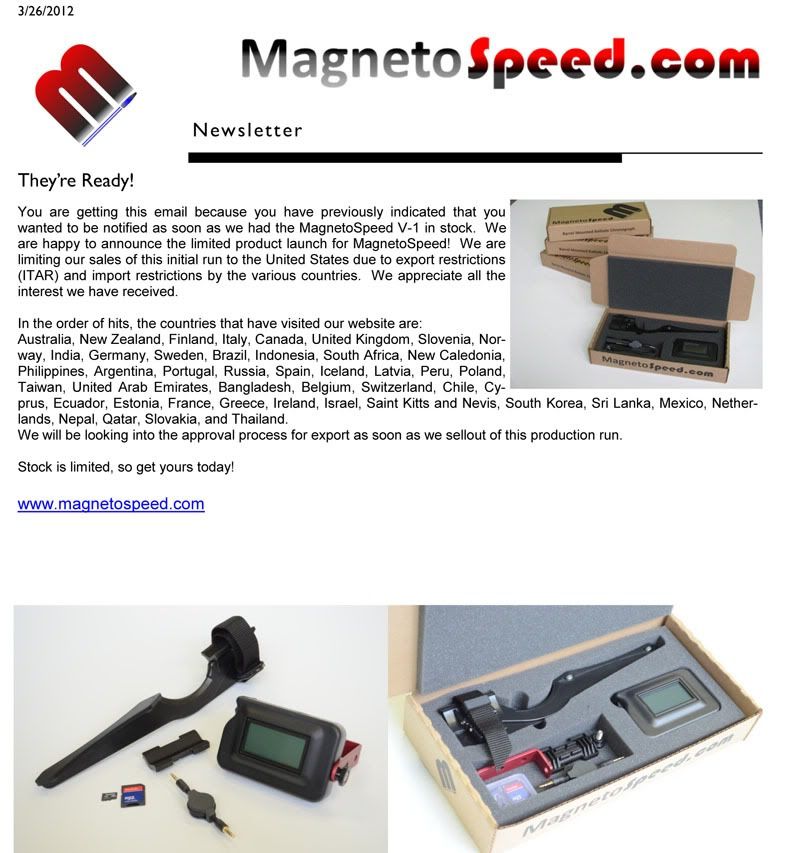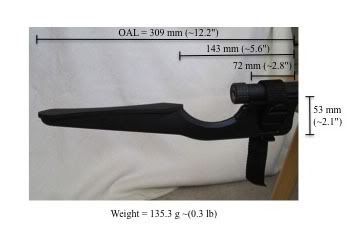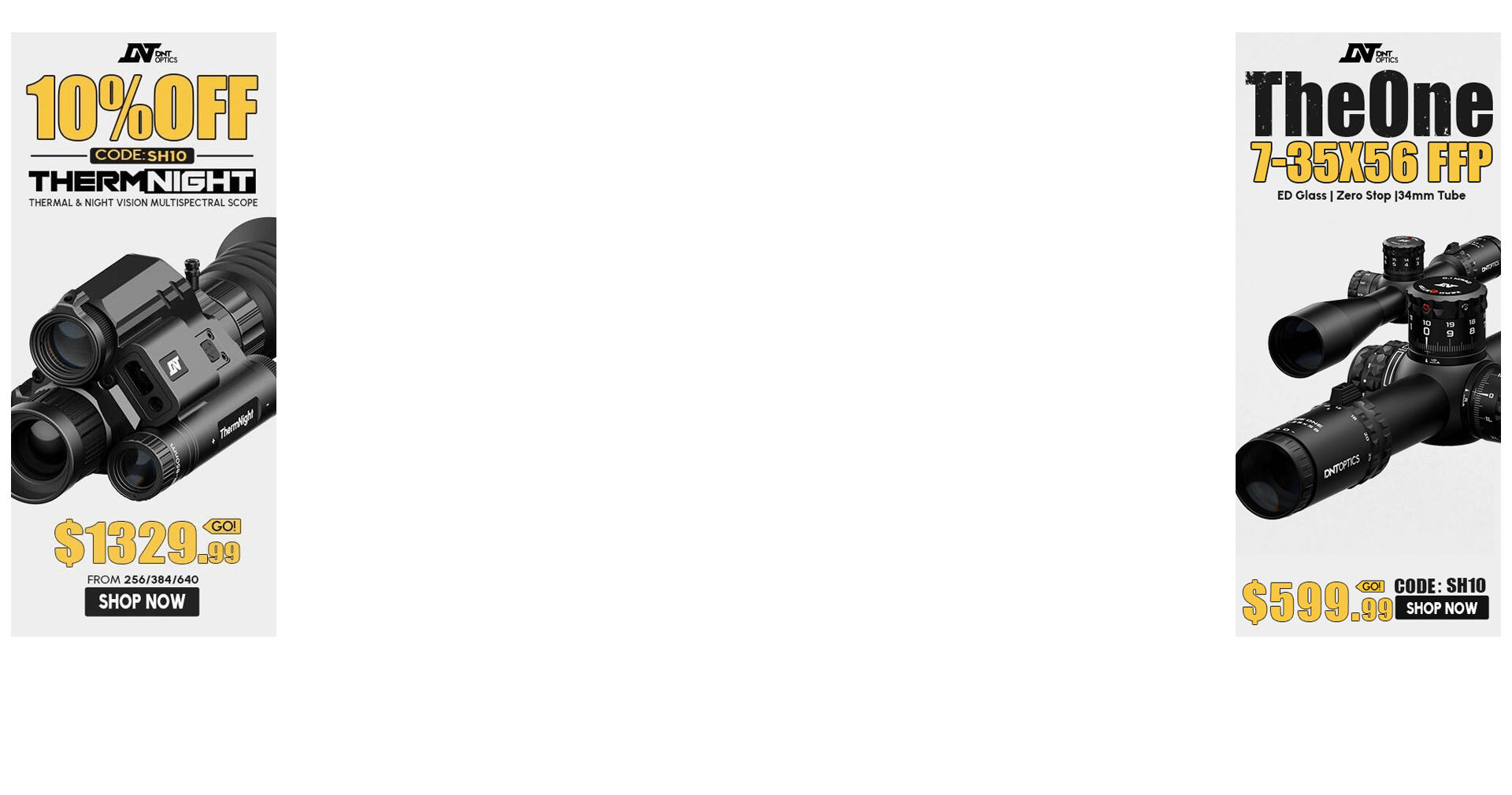Sometime last fall, I became aware of a company (MagnetoSpeed) that was advertising a shooting chronograph that would employ an electromagnetic sensor to measure projectile velocity, rather than light sensors as commonly used in other moderately priced chronographs. The potential advantages to such a system including ease of use and lack of dependence on ambient lighting conditions were immediately obvious to me, so I got on a mailing list to be notified when the units were available for purchase. I ordered the unit immediately and received it last week. I carried out a comparison of the MagnetoSpeed unit, shooting 3 different types of ammunition simultaneously with the MagnetoSpeed unit and my Shooting Crony Beta Master unit. Here are the results of those tests and my take on the MagnetoSpeed shooting chronometer.
The cost of the MagnetoSpeed unit was $250.00, plus tax and shipping. This is almost exactly double the cost of my shooting Chrony Beta Master, not including the cost of the tripod required for using the Chrony. The MagnetoSpeed arrived and the packaging and unit inside are shown in the Figures below:
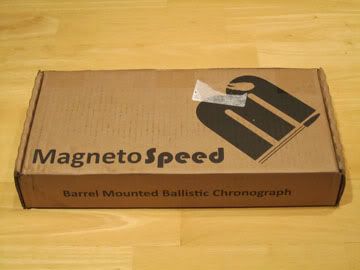
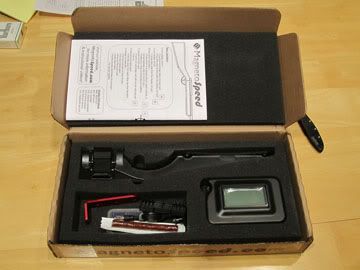
My initial impression of the unit was that it appeared to be very cheaply made, which was not initially encouraging considering the I'd just dropped over $250.00 dollars on it. However, appearances can be deceiving, so I'll return to this point later in the review.
I next tested the MagnetoSpeed chronometer simultaneously with my Shooting Chrony Beta Master using three different factory loads: Hornady 150 gr SSTs (factory test MV = 2820 fps), Federal Gold Medal Match 168 gr SMKs (factory test MV = 2650 fps), and CorBon 190 gr SMKs (factory test MV = 2600 fps). These loads were fired out of a GA Precision Hospitaller with a 24" barrel. Weather conditions were nearly perfect: mostly sunny, 70 degrees F, 40% humidity, 29.94" Hg, with very little wind (1-2 mph from ~7:30).
For the test, I first zeroed at 100 yd, then fired 10 shots for each ammunition at an orange 10"x12" steel plate, simultaneously measuring MV values with the MagnetoSpeed and the Chrony, which was set at 15' in front of the rifle. The MagnetoSpeed took all of about two minutes to install and prepare for use, in contrast the Chrony, which required a more labor-intensive setup using the tripod and positioning to align my shots with the steel plate at 100 yd. The test setup and closeups of the mounted MagnetoSpeed and Chrony are shown in the following images:
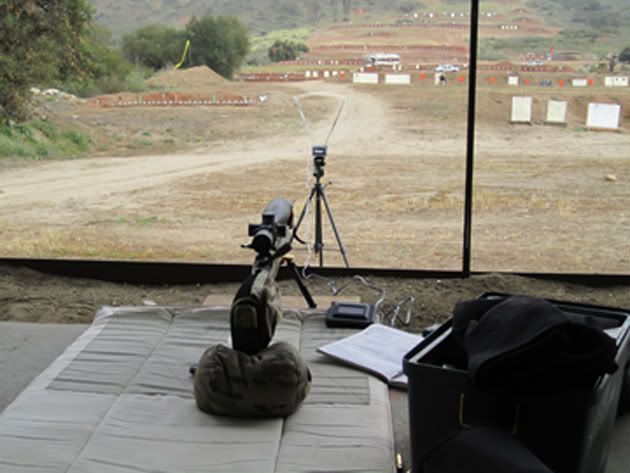
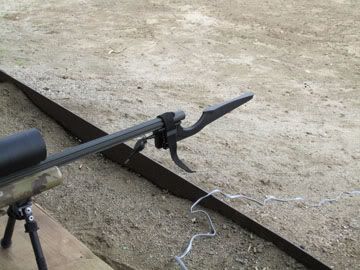
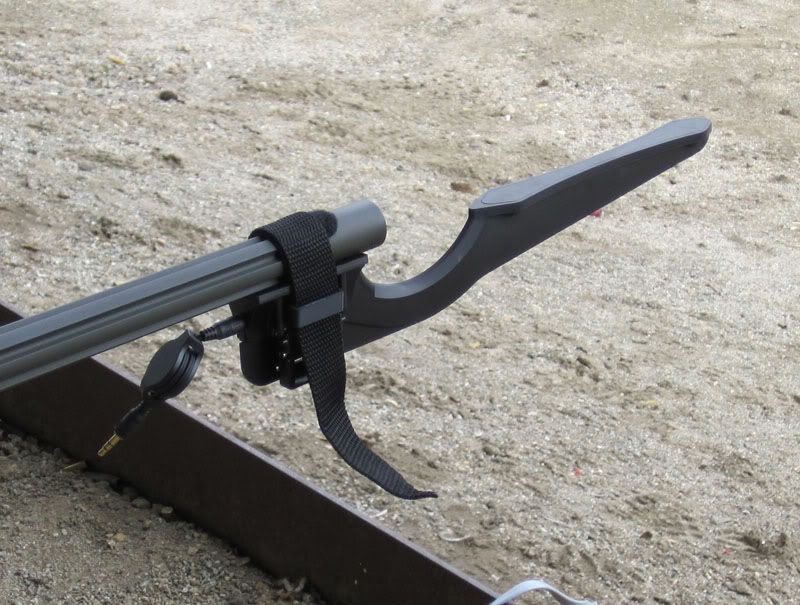
Shots were fired approximately one every minute, with a 10 minute interval between 10-shot strings for different loads to ensure the barrel was cooled down. The values recorded for the two units are shown in the following table:
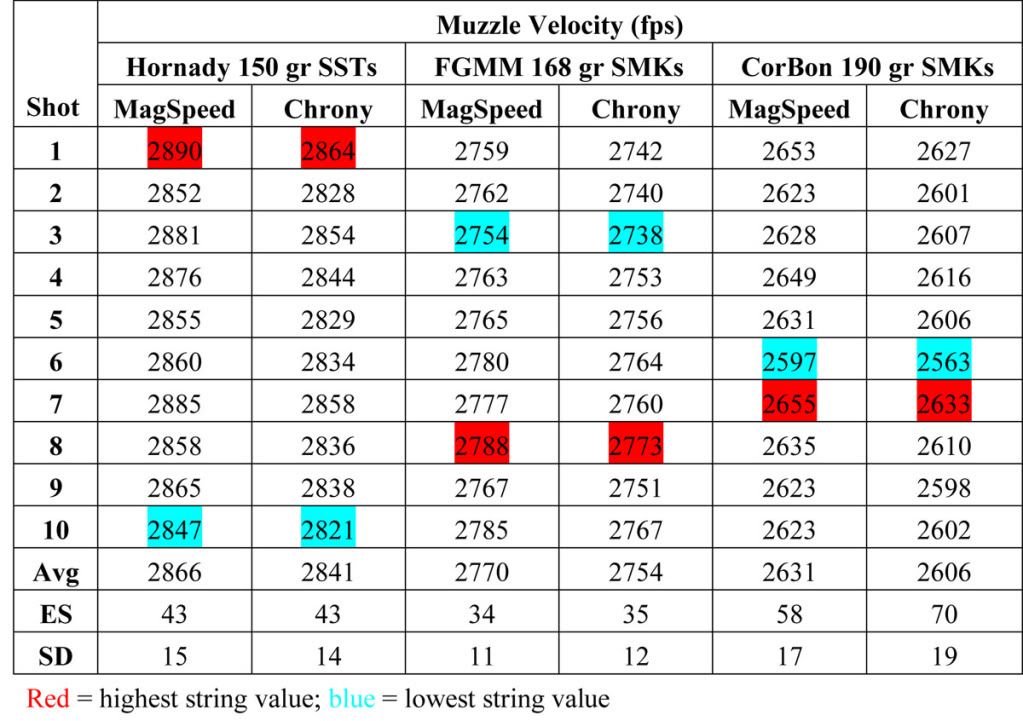
In looking over the data, it was immediately obvious that the only significant difference between the data sets for each of the chronographs is that the MagnetoSpeed gave MV readings tha ranged from ~15-25 fps higher than did the Chrony. Otherwise, the ES and SD values, as well as the shot number of high and low values for each string were statistically identical.
Because the only significant difference between the values recorded with each unit was that the MagnetoSpeed values were slightly higher, I then ran the MV numbers from the MagnetoSpeed through the JBM calculator to determine how much velocity might be lost in the 15' that separated the two units. According to JBM, the MVs for the 150s, 168s, and 190s were predicted to slow by 11, 10, and 8 fps, respectively, in the 15' that separated the two units. This would account for most, although not all, of the velocity differences recorded between the two chronographs.
Next, I zeroed the rifle on steel plates at 600 yd to record the actual drop for each load at that distance. I later compared the actual drops at 600 yd to those predicted by JBM using the average muzzle velocities recorded with each chronograph. These data are shown in the following table:

As can been seen from the numbers, the drops calculated using the MVs from both units were a very close match to those actually observed at 600 yd. The Chrony was slightly closer with two of the loads (FGMM 168s, CorBon 190s), whereas the MagnetoSpeed was a better fit for the Hornady 150s. Having said that, I would say there could be as much as a .125-.250 MOA variance in my actual recorded drops (1-2 clicks elevation), so in essence, there is probably no statistical difference in the values recorded with either unit.
After this test, my overall take on the MagnetoSpeed is far more favorable than my initial impression. What I first perceived as cheap construction, I would now characterize as "simple". The MagnetoSpeed is extremely simple in both construction and use, not cheaply made as I had first thought. After 30 shots, the was not a single mark or trace of residue on it, even though it was placed directly under the muzzle blast. The viewscreen, although small, can easily been seen to record shot data when shooting. The inherent issues with a light-based shooting chronograph are the labor-intensive nature of the setup, which requires the range be "cold" to go in front of the firing line. Further, light conditions and shot placement directly over the sensors are important considerations for obtaining good data. Finally, if you've ever "shot the Chrony" (I have), you'll be very aware of the care needed when using a unit of that type. I often don't use the Chrony because of the hassle of lining it up for shots at distance when practicing for LR competitions. With the MagnetoSpeed, none of these are issues. You put it on the barrel, check the bore is clear, then shoot where you wish. It is possible that the MagnetoSpeed unit might cause a change in barrel harmonics, being attached to the end of the barrel. However, I was able to put 8 rounds of the Hornady 150s into a group of less than 2" at 600 yd on the steel plate I was using as a target. So my feeling is that the effect is probably minimal. Bottom line, whether the MagnetoSpeed is worth the extra cash over the cost of a light-based unit such as the Shooting Chrony is a personal decision. As for me, I am very satisfied with the purchase.
The cost of the MagnetoSpeed unit was $250.00, plus tax and shipping. This is almost exactly double the cost of my shooting Chrony Beta Master, not including the cost of the tripod required for using the Chrony. The MagnetoSpeed arrived and the packaging and unit inside are shown in the Figures below:


My initial impression of the unit was that it appeared to be very cheaply made, which was not initially encouraging considering the I'd just dropped over $250.00 dollars on it. However, appearances can be deceiving, so I'll return to this point later in the review.
I next tested the MagnetoSpeed chronometer simultaneously with my Shooting Chrony Beta Master using three different factory loads: Hornady 150 gr SSTs (factory test MV = 2820 fps), Federal Gold Medal Match 168 gr SMKs (factory test MV = 2650 fps), and CorBon 190 gr SMKs (factory test MV = 2600 fps). These loads were fired out of a GA Precision Hospitaller with a 24" barrel. Weather conditions were nearly perfect: mostly sunny, 70 degrees F, 40% humidity, 29.94" Hg, with very little wind (1-2 mph from ~7:30).
For the test, I first zeroed at 100 yd, then fired 10 shots for each ammunition at an orange 10"x12" steel plate, simultaneously measuring MV values with the MagnetoSpeed and the Chrony, which was set at 15' in front of the rifle. The MagnetoSpeed took all of about two minutes to install and prepare for use, in contrast the Chrony, which required a more labor-intensive setup using the tripod and positioning to align my shots with the steel plate at 100 yd. The test setup and closeups of the mounted MagnetoSpeed and Chrony are shown in the following images:



Shots were fired approximately one every minute, with a 10 minute interval between 10-shot strings for different loads to ensure the barrel was cooled down. The values recorded for the two units are shown in the following table:

In looking over the data, it was immediately obvious that the only significant difference between the data sets for each of the chronographs is that the MagnetoSpeed gave MV readings tha ranged from ~15-25 fps higher than did the Chrony. Otherwise, the ES and SD values, as well as the shot number of high and low values for each string were statistically identical.
Because the only significant difference between the values recorded with each unit was that the MagnetoSpeed values were slightly higher, I then ran the MV numbers from the MagnetoSpeed through the JBM calculator to determine how much velocity might be lost in the 15' that separated the two units. According to JBM, the MVs for the 150s, 168s, and 190s were predicted to slow by 11, 10, and 8 fps, respectively, in the 15' that separated the two units. This would account for most, although not all, of the velocity differences recorded between the two chronographs.
Next, I zeroed the rifle on steel plates at 600 yd to record the actual drop for each load at that distance. I later compared the actual drops at 600 yd to those predicted by JBM using the average muzzle velocities recorded with each chronograph. These data are shown in the following table:

As can been seen from the numbers, the drops calculated using the MVs from both units were a very close match to those actually observed at 600 yd. The Chrony was slightly closer with two of the loads (FGMM 168s, CorBon 190s), whereas the MagnetoSpeed was a better fit for the Hornady 150s. Having said that, I would say there could be as much as a .125-.250 MOA variance in my actual recorded drops (1-2 clicks elevation), so in essence, there is probably no statistical difference in the values recorded with either unit.
After this test, my overall take on the MagnetoSpeed is far more favorable than my initial impression. What I first perceived as cheap construction, I would now characterize as "simple". The MagnetoSpeed is extremely simple in both construction and use, not cheaply made as I had first thought. After 30 shots, the was not a single mark or trace of residue on it, even though it was placed directly under the muzzle blast. The viewscreen, although small, can easily been seen to record shot data when shooting. The inherent issues with a light-based shooting chronograph are the labor-intensive nature of the setup, which requires the range be "cold" to go in front of the firing line. Further, light conditions and shot placement directly over the sensors are important considerations for obtaining good data. Finally, if you've ever "shot the Chrony" (I have), you'll be very aware of the care needed when using a unit of that type. I often don't use the Chrony because of the hassle of lining it up for shots at distance when practicing for LR competitions. With the MagnetoSpeed, none of these are issues. You put it on the barrel, check the bore is clear, then shoot where you wish. It is possible that the MagnetoSpeed unit might cause a change in barrel harmonics, being attached to the end of the barrel. However, I was able to put 8 rounds of the Hornady 150s into a group of less than 2" at 600 yd on the steel plate I was using as a target. So my feeling is that the effect is probably minimal. Bottom line, whether the MagnetoSpeed is worth the extra cash over the cost of a light-based unit such as the Shooting Chrony is a personal decision. As for me, I am very satisfied with the purchase.

